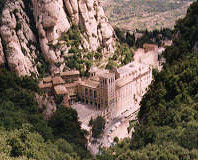The Average Nobleperson’s Guide to Early Music Recordings
Part II
Mother Mary’s Music from the Montserrat Monastery,
or,
The Scarlet Llibre
by Lord Samuel Piper
There are numerous modern recordings of the pieces from Llibre Vermell. I shall discuss versions by Philip Pickett and the New London Consort (L’Oiseau Lyre CD 433-186, DDD, full price), Jordi Savall and Hesperion XX (Virgin Veritas CD 7243 5 61174 2 6, ADD, mid-price), and a recording that includes 6 of the pieces – by Sonus entitled “Songs and Dances of the Middle Ages” (Dorian Discovery CD DIS-80109, DDD, mid-price). Both the Pickett and Savall versions are devoted to Llibre Vermell and contain no other music.
Like most medieval music, there are no written indications of how to perform the Llibre Vermell ssongss (oops – I got carried away). Pickett and Savall perform with solo singers, choirs and instruments of various kinds. The group Sonus consists of 3 people, so their music does not have the big production feel of the others; their performances are generally harp and voice with some flute and percussion thrown in.
Pickett’s recording has a wide variety of instruments, all of which are really in period, believe it or not. These include hammered dulcimer and xylophone, every alphabet book’s favorite x word. Even so, many of the pieces are performed only with voices. The piece “Stella Splendens” is performed with such primal intensity that, instead of Christians, I think of Pagans jumping around, beating drums and generally being in a religious fervor. This recording is very polished and fairly mellow.
Savall’s recording is generally more brisk and often more “Spanish.” Instruments play in every piece except for one. “Los Sept Goyts” has a real middle-eastern feel and is performed with great exotic flair. It is shorter, faster and more varied, and that is good for people with short attention spans (and you know who you are, assuming that you are still reading).
The Sonus album, without big choirs and lot of instruments, is an intimate affair. So if you like intimate affairs, this is the one for you. Let me rephrase that. The music is performed with more poignancy and immediacy, since there are only 3 performers here, but without the grandeur that works so well for some of the songs. And no Pagans either. Although you get only six of the ten Llibre Vermell songs (probably the six you would like best anyway), you also get a song from Carmina Burana (reviewed soon), pieces from Alfonso X’s Cantigas de Santa Maria (reviewed in Part I ), a couple of Medieval dances (to be reviewed in Part III) and a few other assorted pieces (don’t hold your breath). It is a good sampler of Medieval music.
If I must recommend a single recording of these pilgrim songs written for use at the shrine of the Blessed Mary, I would have to pick the Jordi Savall recording. After all, it is issued by Virgin records.


